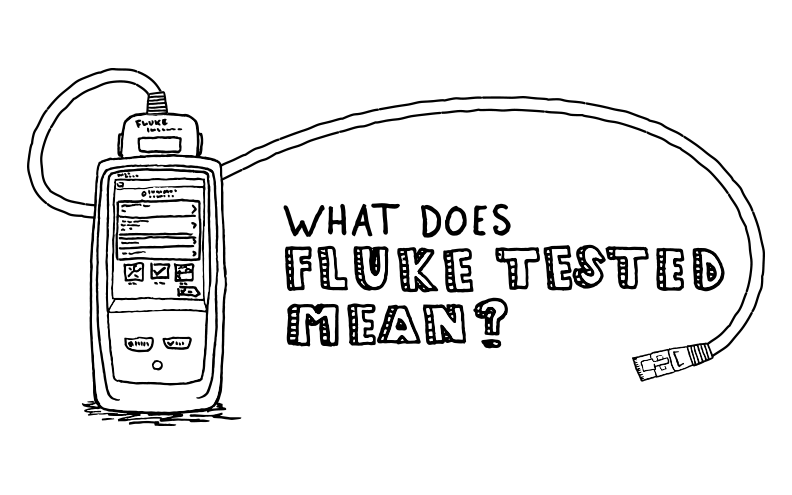Payment methods accepted

What Does Fluke Tested Mean?
Written by Don Schultz, trueCABLE Senior Technical Advisor, Fluke Networks Copper/Fiber CCTT, BICSI INST1, INSTC, INSTF Certified
When testing your Ethernet network, you have a few options. As detailed in the Free Whitepaper: Testing 10 Gigabit Ethernet Over Copper on a Shoestring Budget, the most extensive (and expensive) option is to Certify your cable runs.
Certification against the ANSI/TIA 568 (or ISO/IEC 11801 outside of North America) series of specifications is the “final word” in testing. Essentially, Certification provides hard evidence that your structured cabling system performs precisely as specified per the standard. There are a number of Certification devices on the market, some designed to be used in a factory setting during production and additional devices designed to be used in the field upon completion of installation.
trueCABLE makes use of a Certification device in our production processes. We further make use of a Certification device during periodic randomized quality control and product development processes. Our customers can rest assured that what they buy is up to the task, but keep in mind that there are rules, guidelines, and best practices you should follow that will greatly affect the outcome of your installation!
There are two overarching types of Certification:
- Factory Certification. The manufacturer (like trueCABLE) should perform factory Certification tests on the raw product before you get it. This applies to any component that is outlined in the standard with associated performance metrics around it. Items like solid copper Ethernet cable, keystone jacks, and patch cords are all components outlined in the standard. Despite the factory testing, once you install your products you alter what the manufacturer shipped you (pulling and cutting cable, etc.). Now your structured cable system is technically neither verified or Certified. It must be field tested, somehow.
- Field Certification. Field Certification, necessarily, must take place once all the physical work is done. Often it is demanded on large corporate installs where a contract is involved. In some cases, the manufacturer of the Ethernet cable will not pass along a warranty unless presented with post-install Certification test results.
The Fluke Networks DSX-8000 Versiv2 CableAnalyzer is an example of a field grade Certification instrument and is considered the ultimate guarantee for measuring the performance of an Ethernet cable installation at the physical layer. The DSX-8000 does not perform a “Fluke network test”. There are Fluke network testers that establish TCP/IP connections for logical network testing, but actual Certification is something different. During Certification, the IP network is not tested at all. The DSX-8000 performs electrical measurements on your physical wires against the standard and will result in a PASS or FAIL.
The folks most likely to demand full blown ANSI/TIA 568 Certification of their installation are:
- Medium and large business, and even some smaller businesses too
- Hospitals, clinics, and other medical/laboratory related industry
- Federal, State, and even local Government jurisdictions
- Any network that must work, no matter what, because property, life, or large amounts of money are on the line
- ...probably not your grandmother, but you never know
To be clear, Fluke Networks does not test third-party cable installations or products in the field or factory. Fluke Networks makes the testing devices for others to use (and they make a ton of different kinds for different industries). Not only do they offer the test equipment, but training and extensive blogs are also found on their website covering the latest industry standards and tips.
So, what is measured? Fluke test results explained.
Simply put, when an Ethernet cable is subjected to a Fluke Versiv CableAnalyzer cable test, there is a battery of tests that may be carried out. These tests range from:
- ANSI/TIA 568 Category standard compliance, using the rules and guidelines around Ethernet cable installations, for permanent links (solid copper structure Ethernet cable) and channels (permanent link + stranded copper patch cables)
- Ethernet cable spool/box testing (typically done in a factory)
- ANSI/TIA Category patch cable testing (RJ45 plug to RJ45 plug terminated Ethernet patch cord)
- Application testing to a certain IEEE standard such as 1000BASE-T
- PoE testing (making sure the cable supports Power over Ethernet for IoT devices, Wi-Fi Access Points, IP cameras, etc.)
- ISO/IEC (International Category standards) testing
Each test type carries certain industry approved criteria, and a number of test metrics are used to test that a cable is performing as designed. In the case of a “full blown” ANSI/TIA 568 Certification of permanent links, a number of tests are performed like:
- Wire Map (checking for physical wiring issues like shorts and mis-wires)
- NEXT, PS NEXT (cross talk near and far end, spots bad cable and excessive untwist of the pairs at the connector)
- Return Loss (cable quality, spots water in your cabling too)
- TDR (length, on the “shortest” pair)
- Propagation Delay (time it takes to send a 10 MHz signal down the cable)
- Delay Skew (difference in signal delay between conductor pairs)
- DC Resistance Unbalance (spots defects in the copper conductors...GREAT WAY TO SPOT CCA CABLE!**)
- Insertion Loss (spots cable over the length limit, and bad cabling)
- ACR-F, PS ACR-F (attenuation crosstalk ratio far end, spots cable over the length limit and bad cable)
- PS ANEXT, PS AACR-F (Cat6A alien (cable to cable) crosstalk testing)
** CCA or Copper Clad Aluminum cable is the bane of the Ethernet industry. The DC Resistance Unbalance test includes DC Loop Resistance as a metric. CCA cable is quite horrible at transmitting data or DC voltage and will show up glaringly in this test. Take a look at our blog Check Your Specs, CCA is Different from Solid Copper if you would like to know why CCA is the last thing you want for your wired network.
Further, the ANSI/TIA 1152 document specifies that individuals using a Certification device also be trained to perform the testing at hand. That is right...the Certifying person should be Certified to run the Certifier! For example, in my case, I am a Fluke Networks Certified Cable Test Technician after taking a training class and passing a test.
Had enough of the techno-babble? How about some pictures…
While the Fluke name is thrown around a lot, not a lot of folks get a chance to actually see one of these devices and get some explanation around what is the box. Well, meet Mr. Flukey.

Fluke DSX-8000 CableAnalyzer main and remote units

Main unit touch screen display

Some of the many tests that can be performed

Permanent link adapters

Channel adapters

Alien crosstalk adapters

Universal couplers, and yes--headphones
You might find the addition of headphones odd. I certainly did when opening the box up and looking at them. As it turns out, these headphones have microphones too. There is one set for the main unit and one for the remote unit. This is how your two people will communicate when moving the units from run to run for testing. Once I figured that out, I felt a bit sheepish. Doh!
So, now you have seen what one of these “Fluke things” looks like. I hope that clears any misconceptions. It cannot be overstated just how useful one of these devices is. Troubleshooting becomes a breeze. Your customers will get professional test reports. There will be no doubt in your mind and the mind of your customer that the cabling installation is what they ordered.
Happy Networking!
trueCABLE presents the information on our website, including the “Cable Academy” blog and live chat support, as a service to our customers and other visitors to our website subject to our website terms and conditions. While the information on this website is about data networking and electrical issues, it is not professional advice and any reliance on such material is at your own risk.



























